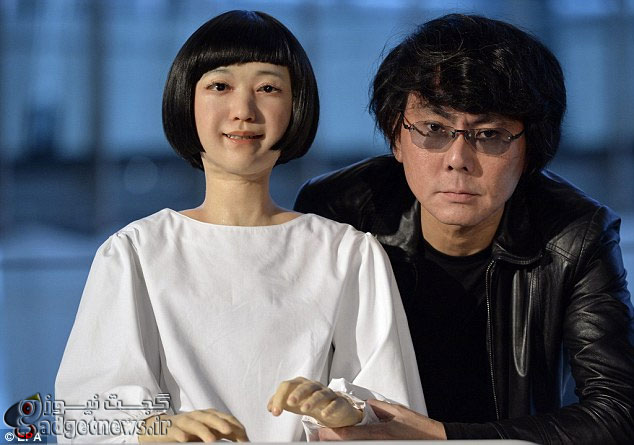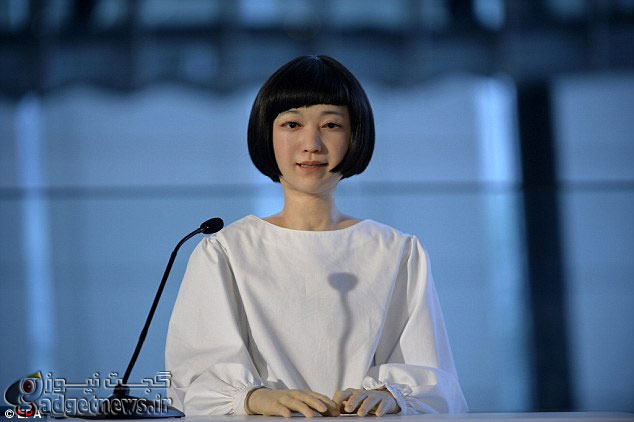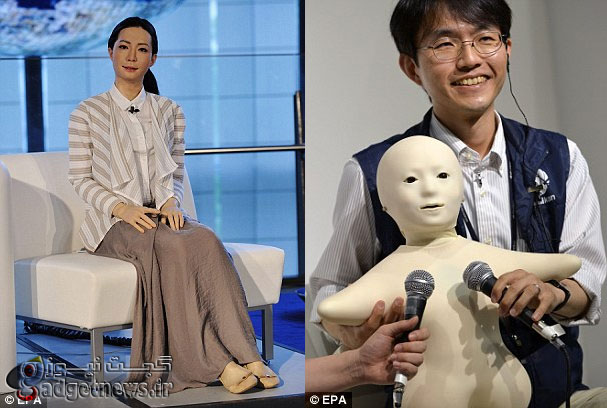
در آينده نه چندان دور ظهور امپراتوران رباتيک در هر نقطه اي ممکن است بساير مخفيانه تر از تصورات کنوني ما باشد . چرا که اين رباتها با چهره هاي انسان نما بسيار غير قابل شناسايي خواهند بود ، شاید این تصورات در آینده دور محقق شوند اما مجموعه جدیدی از رباتهای گوینده خبر با ظاهر واقعی در موزه توکیو به نمایش توسعه پژوهشها در این زمینه پرداختهاند. در ادامه با مشروح اين خبر با گجت نيوز همراه باشيد .
رباتهای «کودوموروید» و «اوتوناروید» با چهرههای انساننما بقدری راحت صحبت میکنند که انگار زنده هستند.به گفته هیروشی ایشیگورو، کارشناس رباتیک ژاپنی و استاد دانشگاه اوساکا، این رباتها برای پژوهش در مورد چگونگی تعامل انسان با ربات مفید خواهند بود. وی اظهار کرد: ساخت اندرویدها برای بررسی حس انسان بودن و پاسخ به این سوالات است که احساسات، آگاهی و تفکر چیست؟

این رباتهای انساننمای کنترل از راه دور در نمایشی، لبهای خود را بطور همزمان با یک دستگاه صدای خارج از تصویر حرکت داده، پلک زده، ابروهای خود را حرکت داده و سر خود را به اطراف تکان میدادند.
کودوموروید و اوتوناروید که نیروی آنها با هوای فشرده و سرووموتور تامین میشود، در حالت نشسته قرار دارند اما میتوانند دستانشان را تکان دهند.در این نمایش، کودوموروید یک بار اخبار را بدون لغزش خوانده و لغات سخت و پیچیده را با زیبایی ادا کرد.

این رباتها که از ظاهری دخترانه برخوردارند، میتوانند در هر زمان صداهای مختلف را مانند صدای بم مردانه یا صدای تیز دخترانه داشته باشند. همچنین میتوان گفتار را بوسیله متن در رباتها وارد کرد تا بیانی شمرده و عالی ارائه کنند.اگرچه اشکالاتی نیز وجود داشت مانند این که لبهای رباتها در زمان سخن گفتنشان تکان نمیخورد یا ربات اوتوناروید با وجودی که دوبار خواسته شد خود را معرفی کند، ساکت ماند. اما به گفته محققان، چنین اشکالاتی در میان رباتها رایج است زیرا آنها دستگاههای ظریفی هستند که به محیط اطرافشان حساسند.

کودوموروید و ربات زن اوتوناروید در کنار نیمتنه «تلنوید» با دستان نوکتیز در این موزه به نمایش درآمدند که به عنوان یک همدم دوستداشتنی عمل میکند.
در نمایشی شبیه پینوکیو، کودوموروید از پروفسور ایشیگورو پرسید که چرا آن را خلق کرده است. ایشیگورو به این سوال چنین پاسخ داد که میخواسته یک گوینده خبر کودک را تولید کند. این رباتها از پوست سیلیکونی و عضلات مصنوعی برخوردارند و در موزه میریکان در توکیو به نمایش درآمدهاند.ایشیگورو همچنین یک ربات انساننما با ظاهر خودش ساخته که آنرا به خارج کشور برای سخنرانی میفرستد.
منبع : dailymail
The Kodomoroid and Otonaroid droids were revealed at Tokyo Museum
Both droids have silicone skin, artificial muscles and are remote-controlled
The creepy-looking robots speak so smoothly they are eerily lifelike
In a demonstration, robots read the news and interacted with the audience
There were some glitches such as lips not moving while one robot spoke
Professor Hiroshi Ishiguro, who developed the robots, has a humanoid version of himself which he sends overseas to give lectures
In a dystopian future, the rise of our robot overlords may be far stealthier than you might expect.
Far from being Terminator-like machines, these robots could look so human that, someday, we may not be able to tell man apart from machine.
That day may still be in the distant future, but a new set of ultra-realistic robot newsreaders at a Tokyo museum reveals just how far research has developed in this area.
Named Kodomoroid and Otonaroid, the creepy-looking robots speak so smoothly they are eerily lifelike.
Japanese robotics expert Hiroshi Ishiguro, an Osaka University professor, said they will be useful for research on how people interact with robots.
‘Making androids is about exploring what it means to be human,’ he told reporters Tuesday, ‘examining the question of what is emotion, what is awareness, what is thinking.’
In a demonstration, the remote-controlled machines moved their lips in time to a voice-over, twitched their eyebrows, blinked and swayed their heads from side-to-side.
Japanese robotic scientist Hiroshi Ishiguro (right) poses next to girl android robot named Kodomoroid (left). In a demonstration, the remote-controlled machines moved their pink lips in time to a voice-over, twitched their eyebrows, blinked and swayed their heads from side to side
Powered by compressed air and servomotors, they were seated but could move their hands.
Kodomoroid read the news without stumbling once and recited complex tongue-twisters glibly.
The robots, designed with a girlish appearance, can use a variety of voices, such as a deep male voice one minute, and a squeaky girly voice the next.
The speech can be input by text, giving them perfect articulation, according to Professor Ishiguro.
There were some glitches – such as the lips not moving at all while the robot spoke, or the Otonaroid announcer robot staying silent twice when asked to introduce itself.
But glitches are common with robots because they are delicate gadgetry sensitive to their environment, said the researchers.
Kodomoroid and the woman robot Otonaroid were joined at the demonstration by the minimally designed Telenoid, a mannequin head with pointed arms that serves as a cuddly companion.
n what appeared like a scene out of ‘Pinocchio’, Kodomoroid asked Professor Ishiguro why he had created it. The professor replied that he wanted to create a child news announcer.
The robots, which have silicone skin and artificial muscles, will be on display from Wednesday, at Miraikan museum, or the National Museum of Emerging Science and Innovation, in Tokyo.
Reflecting widespread opinion, Professor Ishiguro said Japan leads the world in playful companion robots. But he acknowledged the nation was behind the U.S. in military robots.
‘We will have more and more robots in our lives in the future,’ Professor Ishiguro said.
‘You can take my androids on planes – the torso in the suitcase and the head in carry-on.’
Professor Ishiguro has a humanoid version of himself which he sends overseas to give lectures.
‘It cuts down on my business trips,’ he said. ‘Technical advances mean robots look and act more human, and that makes us think about our worth.’
His approach differs from some robotics scientists who say human appearance is pointless, perhaps creepy, and robots can look like machines, such as taking the form of a TV screen or a portable device.
Professor Ishiguro noted proudly how Japanese Internet company Softbank recently showed a robot named Pepper, which looks a little like C-3PO in ‘Star Wars,’ and will sell for 198,000 yen (£1,130 or $1,900).
Pepper’s arrival means robots are increasingly becoming part of everyday life in Japan.
‘Robots are now becoming affordable – no different from owning a laptop,’ said Professor Ishiguro.
 گجت نیوز آخرین اخبار تکنولوژی، علم و خودرو
گجت نیوز آخرین اخبار تکنولوژی، علم و خودرو 





